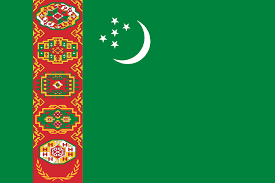Language/Turkmen/Grammar/How-to-Use-Be
Hi Turkmen learners! 😊
In this lesson, we will focus on the verb "be" and how it is used in Turkmen grammar. We will provide examples and cultural information to help you fully understand this concept. By the end of the lesson, you will be able to use "be" correctly in various tenses and situations.
Once you've mastered this lesson, take a look at these related pages: The Subjunctive Mood & Pronouns.
"Be" in Turkmen[edit | edit source]
In Turkmen, the verb "be" is expressed by the word "bolmak." Like in many languages, "be" is a very important verb in Turkmen and is used to link subjects to their descriptions or states. It is an irregular verb, meaning that its stem and endings do not follow the regular patterns of verb conjugation in Turkmen.
To use "be" in Turkmen, you must first understand its basic forms:
| Form | Turkmen | Pronunciation | English |
|---|---|---|---|
| Present Incomplete Tense | bolýär | bo-LYAR | am/is/are ___ing |
| Present Complete Tense | boldy | BOHL-duh | am/is/are ___ed |
| Past Indefinite Tense | boldy | BOHL-duh | was/were ___ |
| Future Tense | bolacak | boh-luh-JAK | will be ___ing/___ed |
Here are a couple of examples to illustrate these forms:
- Siz dogry. (You are right.)
- Ol meni yüzüne aldy. (He looked at me.)
- Onuň täze telefonu boldy. (She has a new phone.)
- Biz yzaja boljak. (We will talk)
As you can see, the form of "be" changes depending on the tense of the sentence.
Using "Be" with Adjectives[edit | edit source]
In Turkmen, "be" is often used to link subjects to their adjectives. Adjectives are words that describe or modify nouns, and in Turkmen, they come after the noun they describe. For example:
- Ol goşundy ije. (He is tall.)
- Sen gowy adamsyň. (You are a good person.)
- Men tassyk bolýarmy? (Am I thirsty?)
In these examples, "be" links the subject to the adjective that describes it.
Using "Be" with Nouns and Pronouns[edit | edit source]
In Turkmen, "be" is also used to link subjects to their nouns and pronouns. Nouns are words that represent people, places, things, or ideas, and pronouns are words that replace nouns. For example:
- Men Türkmenistan-da bolýan. (I am in Turkmenistan.)
- Ol meniň dostym. (He is my friend.)
- Sen şäherde boljak. (You will be in the city.)
Here, "be" links the subject to the noun or pronoun that describes its location or relationship.
Using "Be" in Questions and Negations[edit | edit source]
In Turkmen, "be" is also used in questions and negations. To form questions with "be", you simply switch the order of the subject and the verb. For example:
- Ol wagtyňy bilyärmi? (Does he know the time?)
- Sen otagyňy temizleýärsiňmi? (Will you clean your room?)
To form negations with "be", you simply add the negative particle "ýok" after the verb. For example:
- Meniň aýdymym ýok. (I am not hungry.)
- Ol öz saýtyna girizýär, seniň işiň ýok. (He goes to his own page, you have no business here.)
Examples in Context[edit | edit source]
Now, let's take a look at a dialogue that uses "be" in various tenses and forms:
- Person 1: Mugallym, meniň işim täze boldy. (Teacher, I have a new job.)
- Person 2: Ow, ýatanlyk boldy! (Oh, congratulations!)
- Person 1: Biz gutaram bolýarjagymyzn. (We will be traveling soon.)
- Person 2: Gowy, näme ýeri gezýärsiňiz? (Great, where will you be traveling?)
- Person 1: Türkmenistan-da gezýäris. (We will be traveling in Turkmenistan.)
- Person 2: Ýagtymaly boljak! (Have a safe trip!)
Conclusion[edit | edit source]
We hope this lesson has been helpful in understanding the usage of the verb "be" in Turkmen. Remember that "be" is an essential verb in Turkmen and is used in many different ways. To improve your Turkmen Grammar, you can also use the Polyglot Club website. Find native speakers and ask them any questions!
➡ If you have any questions, please ask them in the comments section below.
➡ Feel free to edit this wiki page if you think it can be improved. 😎
Excellent job on conquering this lesson! Consider delving into these related pages: Plurals & 0 to A1 Course.
Other Lessons[edit | edit source]
- Adjectives
- Past in the past (pluperfect)
- Nouns
- Future Tense
- Negation
- The Case system
- Conditional Mood
- Gender
- Questions
Sources[edit | edit source]

